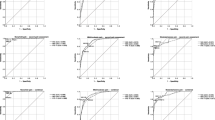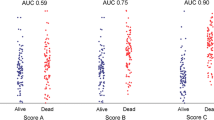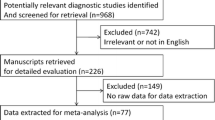Abstract
Background
The ability to predict who will develop perioperative complications remains difficult because the etiology of adverse events is multifactorial. This study examines the preoperative and postoperative ability of the surgeon to predict complications and assesses the significance of a change in prediction.
Methods
This was a prospective study of 1013 patients. The surgeon assessed the risk of a major complication on a 100-mm visual analog scale (VAS) immediately before and after surgery. When the VAS score was changed, the surgeon was asked to document why. Patients were assessed up to 30 days postoperatively.
Results
Surgeons made a meaningful preoperative prediction of major complications (median score = 27mm vs. 19mm, p < 0.01), with an area under the receiver operating characteristic curve of 0.74 for mortality, 0.67 for major complications, and 0.63 for all complications. A change in the VAS score postoperatively was due to technical reasons in 74% of stated cases. An increased VAS score identified significantly more complications, but the improvement in the discrimination was small. When included in a multivariate model for predicting postoperative complications, the surgeon’s VAS score functioned as an independent predictive variable and improved the predictive ability, goodness of fit, and discrimination of the model.
Conclusions
Clinical assessment of risk by the surgeon using a VAS score independently improves the prediction of perioperative complications. Including the unique contribution of the surgeon’s clinical assessment should be considered in models designed to predict the risk of surgery.



Similar content being viewed by others
References
Adab P, Rouse AM, Mohammed MA, et al. (2002) Performance league tables: the NHS deserves better. Br Med J 324:95–98
Pettigrew RA, Hill GL (1986) Indicators of surgical risk and clinical judgement. Br J Surg 73:47–51
Copeland GP (2002) The POSSUM system of surgical audit. Arch Surg 137(1):15–20
Copeland GP, Jones D, Walters M (1991) POSSUM: a scoring system for surgical audit. Br J Surg 78:356–369
Knaus WA (2002) APACHE 1978–2001: The development of a quality assurance system based on prognosis: Milestones and personal reflections. Arch Surg 137:37–42
Knaus WA, Draper EA, Wagner DP, et al. (1985) APACHE II: a severity of disease classification system. Crit Care Med 13:818–829
Sutton R, Bann S, Brooks M, et al. (2002) Surgical Risk Scale as an improved tool for risk-adjusted analysis in comparative surgical audit. Br J Surg 89(6):763–768
Pillai SB, van Rij AM, Williams S, et al. (1999) Complexity and risk adjusted models for measuring surgical outcome. Br J Surg 86:1567–1572
Daley J, Khuri SF, Henderson W, et al. (1997) Risk adjustment of the postoperative morbidity rate for the comparative assessment of the quality of surgical care: results of the National Veterans Affairs Surgical Risk Study. J Am Coll Surg 185(4):328–340
Khuri SF, Daley J, Henderson W, et al. (1997) Risk adjustment of the postoperative mortality rate for the comparative assessment of the quality of surgical care: results of the National Veterans Affairs Surgical Risk Study. J Am Coll Surg 185:315–327
Tekkis PP, Poloniecki JD, Thompson MR, et al. (2002) ACPGBI colorectal cancer study 2002. Part B: Risk adjusted outcomes. The ACPGBI colorectal cancer model. London, Association of Coloproctology of Great Britain and Ireland
Klotz HP, Candinas D, Platz A, et al. (1996) Preoperative risk assessment in elective general surgery. Br J Surg 83:1788–1791
Ondrula DP, Nelson RL, Prasad ML, et al. (1992) Multifactorial Index of Preoperative Risk Factors in colon resections. Dis Colon Rectum 35:117–122
Al-Ruzzeh SI, Asimakopoulos G, Ambler G, et al. (2003) Validation of four different risk stratification systems in patients undergoing off-pump coronary artery bypass surgery: a UK multicentre analysis of 2223 patients. Heart 89(4):432–435
Jones DR, Copeland GP, de Cossart L (1992) Comparison of POSSUM with APACHE II for prediction of outcome from a surgical high dependency unit. Br J Surg 79:1293–1296
Martin IG, Kempthorne AE, Connolly A (2002) Assessing patients for general surgical procedures: how well can we predict outcomes? ANZ J Surg 72(Suppl 1):A24
Pettigrew RA, Burns HJG, Carter DC (1987) Evaluating surgical risk: the importance of technical factors in determining outcome. Br J Surg 74:791–794
Russell RCG (1987) Surgical technique. Br J Surg 74:763–764
Ouriel K, Geary K, Green RM, et al. (1990) Factors determining survival after ruptured aortic aneurysm: The hospital, the surgeon, and the patient. J Vasc Surg 11:493–496
Bancewicz J (1990) Cancer of the oesophagus. Find a good surgeon. Br J Surg 300:3–4
Callahan MA, Christos PJ, Gold HT, et al. (2003) Influence of surgical subspecialty training on in-hospital mortality for colectomy patients. Ann Surg 238(4):629–639
Halm EA, Lee C, Chassin MR (2002) Is volume related to outcome in health care? A systematic review and methodologic critique of the literature. Ann Intern Med 137:511–520
Ingemar I (2003) The volume-outcome relationship in cancer surgery: a hard sell. Ann Surg 238(6):777–781
Woodfield JC, van Rij AM, Pettigrew RA, et al. (2003) A comparison of the prophylactic efficacy of ceftriaxone and cefotaxime in abdominal surgery. Am J Surg 185:45–49
Department of Surgery Clinical Audit Research Unit (1996) The Otago Audit System: Codes for Surgical Audit (General/Vascular) 1996 Revision. Dunedin, New Zealand, University of Otago
Arvidsson S, Ouchterlony J, Sjostedt L, et al. (1996) Predicting postoperative adverse events. Clinical efficiency of four general classification systems. The project perioperative risk. Acta Anaesthesiol Scand 40:783–791
Hartley MN, Sagar PM (1994) The surgeons gut feeling as a predictor of postoperative outcome. Ann R Coll Surg Engl 76(Suppl 6):277–278
Markus PM, Martell I, Leister O, et al. (2005) Predicting postoperative morbidity by clinical assessment. Br J Surg 92:101–106
Author information
Authors and Affiliations
Corresponding author
Rights and permissions
About this article
Cite this article
Woodfield, J.C., Pettigrew, R.A., Plank, L.D. et al. Accuracy of the Surgeons’ Clinical Prediction of Perioperative Complications Using a Visual Analog Scale. World J Surg 31, 1912–1920 (2007). https://doi.org/10.1007/s00268-007-9178-0
Published:
Issue Date:
DOI: https://doi.org/10.1007/s00268-007-9178-0




